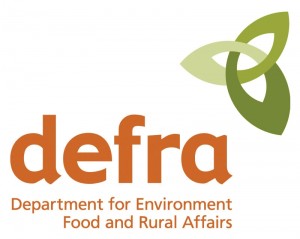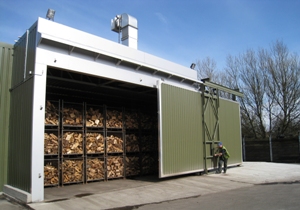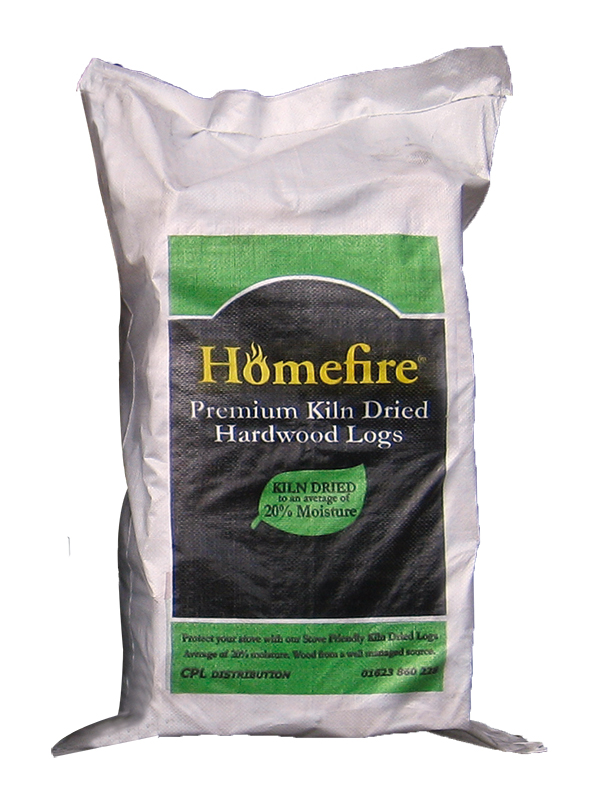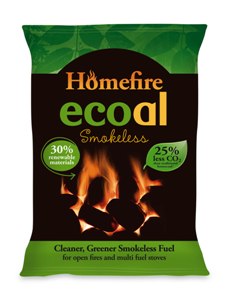Why am I being asked for my postcode?
We supply all throughout the UK, so knowing your postcode means we can select the right local merchant and give you the best price!

Although claims that stoves could be banned were certainly wide of the mark; being subsequently refuted by the Mayor of London’s office, Government and Industry have been working to tackle this problem:
|
Fuel |
|
Smoke (PM2.5) emissions |
|
Wet Wood (over 25% moisture content) |
|
25 grammes per hour |
|
Dry Wood (less than 20% moisture) |
|
5 grammes per hour |
|
House Coal |
|
25 grammes per hour |
|
Authorised Smokeless Fuel |
|
5 grammes per hour |
The above smoke emissions data is based on independent fuel testing data.

Currently approximately 2.5 million tonnes of firewood and 0.75 million tonnes of solid fuel is burnt in UK homes each year. At present only 10 percent of the firewood burnt is kiln dried wood of less than 20 percent moisture. Although a substantial amount of wood is seasoned, a lot of wood is over 20 percent moisture and contributes significantly to PM2.5 pollution. Looking at solid fuels, circa 300,000 to 350,000 tonnes of house coal is burnt per year, which generates five times the PM2.5 pollution of authorised smokeless fuels.
Should all the burning of house coal and wet wood in the home be converted to either dry firewood or authorised smokeless coal, then particulate emissions from the home could be reduced by between 70 and 80 percent, reducing total UK PM2.5 pollution by up to 29 percent.
Kiln Dried or Seasoned Wood?
When first felled , wood contains up to 60 percent moisture and is unsuitable for burning. The wood is stacked within the forest where the natural seasoning (drying out) process starts and then transported. Despite this initial drying period, the wood still has a moisture content of up to 45 percent when presented for chopping or packing.
Wood can be dried further, by two methods.

Seasoning involves stacking the wood and allowing it to dry naturally in barns or shelters. The length of time and the effectiveness of the seasoning will vary and hence the moisture content will vary significantly, unless a similar control system to that used for kiln dried wood is employed.
Testing by independent laboratories has shown that burning wood with less than 20 percent moisture content very significantly reduces smoke particle emissions. Kiln Dried wood that has achieved Ready to Burn approval is the best assurance that the 20 percent moisture content has been achieved, resulting in a product that is not only superior in terms of heat output, but has smoke emissions of five times less than freshly felled wood.

No. Both in the case of authorised smokeless solid fuels and Ready to Burn kiln dried wood, these low emissions fuels offer better value to consumers than house coal or wet wood.
In the case of smokeless solid fuels, they have lower volatile gas content and so while burning with less of a flame than coal they burn up to 30 percent more efficiently. (Result supported by independent testing over many years). In practical terms, the smokeless solid fuel releases 30 percent more heat into the room per kilogram burnt than house coal, so whilst the bag price might be circa 20 percent higher in cost, the actual heating cost is 10 to 14 percent lower. This is supported by SEAI findings in Ireland and independent testing in the UK.
Please see the table below:
|
|
House Coal |
|
Smokeless Fuel |
|
Price per 10kg |
£2.99 |
|
£3.99 |
|
Price per tonne |
£299 |
|
£399 |
|
Energy Content (Kwh per tonne) |
7900 |
|
8850 |
|
Burning Efficiency (energy in fuel compared to heat in room) |
28% |
|
37% |
|
Effective Kwh in room per tonne |
2212 |
|
3274 |
|
Cost per Kwh in Room |
£0.135 |
|
£0.12 |
|
|
Radiant Heat* |
Price per m3 |
Price per kg |
Price per Radiant Heat |
|
Unseasoned Wood |
0.38 |
£75 |
£0.15 |
£0.39 |
|
Kiln Dried wood (Less than 20% moisture) |
0.62 |
£120 |
£0.24 |
£0.39 |
|
*Radiant Heat represents heat released into the room i.e. useable heat |
||||
Conclusion
There is no doubt that having a fire on a winter’s evening is a pleasure for many people. Doing so can still be environmentally responsible, providing the right fuels such as authorised smokeless fuels or Ready to Burn Firewood are used, helping to reduce smoke and particulates by up to five times compared to wet unseasoned wood and house coal.
The Ready to Burn scheme, recently launched by DEFRA provides consumers with an easy way to identify firewood products, including manufactured heat logs, that have a moisture content of less than 20 percent and are, therefore, are better for the environment; burning with reduced particulates.
Smokeless solid fuels provide another solution, having been developed to address the same issue of air quality back in the 1950’s.

In 2017 Homefire continues to focus on new, environmentally friendlier fuels, with the launch of Homefire Supercharged Heat Logs to market. This is a fully renewable, low smoke, wood-based product, manufactured using a new process called Torrefaction to provide a fuel with 30 percent more energy than kiln dried wood and with a longer lasting fire.
Only use the form below to ask a question about this specific product.
For all non-product related enquires please use our contact form (https://www.coals2u.co.uk/contact-us-coals2u)
We deliver the traditional way. Bagged coal and firewood (up to 50kg) are delivered exactly where you need them. In your fuel store or even by the fireside
Orders over 50kg (bulk bags, pallets or crates) are delivered as close to where you want as possible, which may be the kerbside
The cost of delivery is included in the price of the goods
In the unlikely event that you're not happy with your order, it can be returned within 14 days by arranged collection
We supply all throughout the UK, so knowing your postcode means we can select the right local merchant and give you the best price!